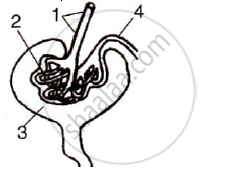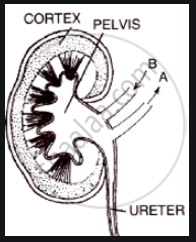Advertisements
Advertisements
Question
How is the amount of urine produced regulated?
Solution 1
The amount of urine produced depends on the amount of excess water and dissolved wastes present in the body. Other factors, such as an organism's habitat and hormones such as Anti-diuretic hormone (ADH), also regulate the amount of urine produced.
Solution 2
- The amount of urine produced is controlled by a hormone released from the posterior lobe of the pituitary gland, called antidiuretic hormone (ADH) or vasopressin. This hormone's role is to promote the reabsorption of water from the nephric filtrate.
- When there is sufficient water in the blood, less ADH is secreted, resulting in less water being reabsorbed from the nephric filtrate and, therefore, more urine is produced. Conversely, when there is less water in the blood, more ADH is released, leading to increased water reabsorption by the blood capillaries surrounding the nephron, which reduces the amount of urine produced.
APPEARS IN
RELATED QUESTIONS
Draw a diagram of the human excretory system and label the various parts.
_____________ secreted by the (ii) _____________ lobe of the pituitary gland. If this hormone secretion is reduced, there is an increased production of urine. This disorder is called (iii) ____________. Sometimes excess glucose is passed with urine due to hyposecretion of another hormone called (iv) _____________ leading to the cause of a disease called (v) ______________.
the Biological/technical term Pigment providing colour to urine.
Explain Selective reabsorption
Write the functions of Kidney
Fill in the following blank with suitable word:
Gums and resins are the .......... products of plants.
What is the name of the tubes which connect the kidneys to bladder?
What are the methods used by plants to get rid of their waste products?
What is meant by dialysis? What type of patients are put on dialysis?
Explain the principle of dialysis with the help of a labelled diagram.
The substance which is not reabsorbed into the blood capillaries surrounding the tuble of a nephron is mainly:
(a) glucose
(b) amino acid
(c) urea
(d) water
State if the following statement is true or false. Correct the statement if it is false.
Liver produces bile pigments from the hemoglobin of broken RBCs.
Answer the following in short.
Define transpiration in plants.
Answer the following in detail.
Describe the process of urine formation.
Given below is a set of five terms. Rewrite the terms in their correct order so as to be in logical sequence.
Renal artery, urethra, ureter, kidney, urinary bladder.
Differentiate between the following pairs of term :
Renal cortex and renal medulla
Study the diagram given alongside and then answer the question that follow:
Name the region in the kidney where the above structure is present?

Choose the correct answer:
Narrow apex of pyramid in kidney is called ___________
Given below is a highly simplified diagram of the human kidney cut open longitudinally. Answer the question that follow:
Name the functional units of the kidneys.

Name the Following
The process by which kidneys regulate the water content of the body.
Write the functional activity of the following structure: Renal vein
Choose the Odd One Out:
Choose the correct option.
Visceral layer : Podocytes :: PCT : ________.
Choose the correct option.
The minor calyx _______.
Answer the following question.
Amphibian tadpole can afford to be ammonotelic. Justify.
The product of the process of deamination is ______.
Elimination of nitrogenous wastes in the form of uric acid takes place in ____________.
If a plant is releasing carbon dioxide and taking in oxygen during the day, does it mean that there is no photosynthesis occurring? Justify your answer.
What is the purpose of making urine in the human body?
Name the following:
The main nitrogenous waste formed in the body.
Give two examples of the following:
Nitrogenous waste
Give two examples of the following:
Water-soluble vitamins
The main nitrogenous waste formed in the human body:
The statement given below is false. Rewrite the correct form of the statement by changing the underlined word.
The pigment urochrome is the breakdown product of the haemoglobin of dead RBCs.
Give reason:
Excretion is a necessary process of our body.
